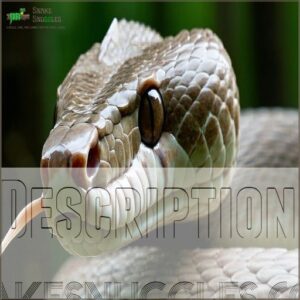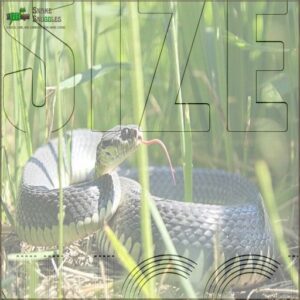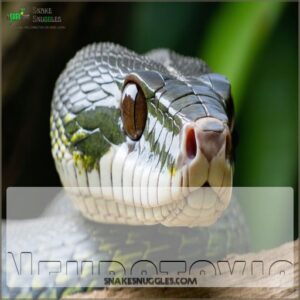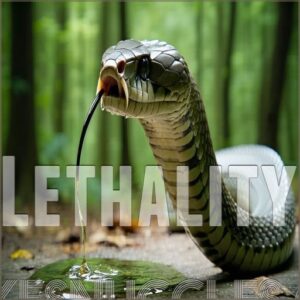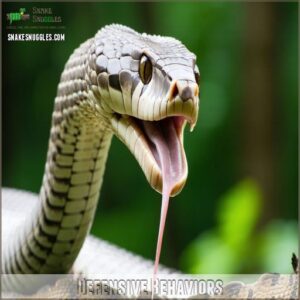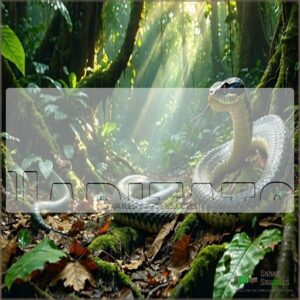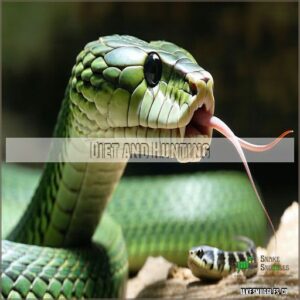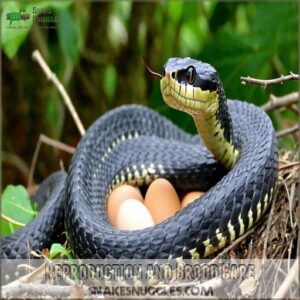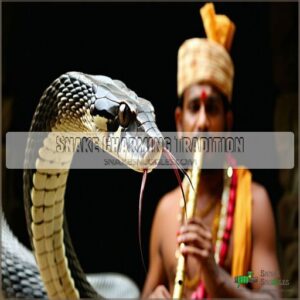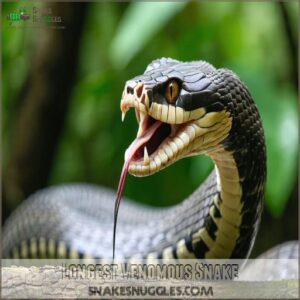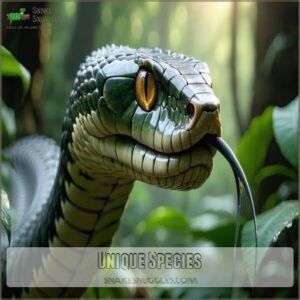This site is supported by our readers. We may earn a commission, at no cost to you, if you purchase through links.
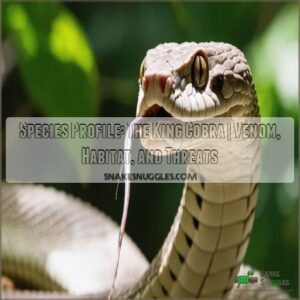
Growing up to 18 feet long, it’s not just a slithering giant but also a master of venomous defense, packing a neurotoxic punch powerful enough to take down an elephant.
Native to the lush forests and wetlands of Asia, this creature is unique as the sole member of the genus Ophiophagus.
A keen hunter, it prefers dining on other snakes, even its own kind.
Curious about its mysterious nesting habits or the threats it faces? Stay tuned!
Table Of Contents
- Key Takeaways
- What is The King Cobra?
- Venom Potency
- Defensive Behaviors
- Habitats
- Diet and Hunting
- Reproduction and Brood Care
- Threats and Conservation
- Snake Charming Tradition
- Longest Venomous Snake
- Unique Species
- Frequently Asked Questions (FAQs)
- Is a king cobra a single species?
- How do you identify a king cobra?
- Are king cobras different from other snakes?
- Are king cobras aquatic snakes?
- How big is a king cobra?
- Who discovered a king cobra?
- What is the profile of king cobra?
- What type of species is a king cobra?
- What family is the king cobra in?
- What are 5 facts about king cobras?
- How often do king cobras shed their skin?
- What are king cobras natural predators?
- Can king cobras climb trees effectively?
- How long do king cobras live in captivity?
- Do king cobras have any unique behaviors?
- Conclusion
Key Takeaways
- You’ll find the king cobra is the world’s longest venomous snake, reaching up to 18 feet.
- Its potent neurotoxic venom, while not the most toxic, is delivered in large quantities, posing a significant threat.
- You’ll discover that king cobras are apex predators, primarily feeding on other snakes, and display unique nesting and parental care behaviors.
- Habitat loss due to deforestation and illegal wildlife trade are major threats to their survival.
What is The King Cobra?
When you think of the king cobra, picture the world’s longest venomous snake, which can stretch up to 18 feet and is known for its distinctive hood and fierce demeanor.
Found primarily in the lush forests and waterways of South and Southeast Asia, this remarkable reptile plays a key role in maintaining ecological balance by feasting on other snakes and small mammals.
Description
Imagine encountering Ophiophagus hannah, the king cobra.
Its sleek, elongated body, adorned with glossy scales and distinctive pattern variations, makes a striking impression.
Gliding through forests and wetlands, this member of the Elapidae family is a master of camouflage, with a color palette ranging from earthy browns to vibrant greens.
Its crown of 11 distinctive head scales sets it apart in the reptile kingdom.
Size
King cobras are the longest venomous snakes globally, reaching a maximum of 18 feet.
However, they typically measure 10-12 feet.
Size varies, but their impressive length contributes to their intimidating presence.
This Ophiophagus hannah, a member of the Elapidae family, is a sight to behold.
Their size is a key factor in their predatory success.
Range
You’ll spot king cobras slithering through the lush forests and wetlands stretching from northern India to southern China, including Hong Kong.
This wide-ranging territory reveals their adaptability, but also the threats from deforestation and human activity.
Protecting these habitats is critical, reflected in their "Vulnerable" status on the IUCN Red List, emphasizing the need for conservation.
Venom Potency
You’ll find that the king cobra’s venom is a powerful concoction of neurotoxins capable of swiftly shutting down its victim’s nervous system, leading to paralysis.
Notably, while its venom isn’t the most toxic by volume, the sheer quantity delivered is enough to incapacitate much larger creatures.
Neurotoxic
Picture a predator equipped with neurotoxins that incapacitate you in no time.
The king cobra’s venom blocks nerve signals, causing paralysis by the bucketful in one strike.
Though it’s not topping toxicity charts, the sheer volume delivered makes it formidable.
This lethal brew allows the cobra to hunt efficiently while posing a significant threat to humans.
Lethality
Despite the terrifying tales, the king cobra’s venom packs a mighty punch, with a potency that’s often measured using the LD50 scale for venom. A single bite delivers enough venom to potentially kill 20 people or an elephant, primarily causing respiratory arrest and cardiac failure.
However, most bites happen when nests are disturbed or cobras are mishandled.
Balancing awareness of their potency with conservation efforts is key.
- Venom Dose: Significant, swift action.
- Mortality Risk: Serious, if untreated.
- Antivenom: Essential for survival.
Defensive Behaviors
When you encounter a king cobra feeling threatened, it performs an impressive hood display and hissing show that might remind you of a cat puffing up and hissing at a bigger dog.
This behavior isn’t just for dramatics; it effectively makes the cobra look larger and sounds intimidating to warn potential threats that they’re messing with the wrong snake.
Hood Display
When you’re eyeing the king cobra, its hood display isn’t just for show.
By broadening its silhouette, it warns predators and marks its turf.
This grand posture is an evolutionary advantage, making it clear this isn’t the snake to mess with.
The king cobra’s hood is a masterful communication method, signaling threat assessment with striking body language and true animal defense mechanisms.
Hissing
Ever heard a King Cobra hiss?
It’s a chilling sound, a warning sign from nature’s apex predator.
This Hamadryad uses its hissing—air resonating through tiny holes in its trachea—as a potent defense mechanism, a warning signal to potential threats.
This impressive hissing isn’t just noise; it’s communication, a vital part of the King Cobra’s survival strategy.
Habitats
When you think about king cobra habitats, imagine lush forests and intricate wetlands sprawling across South and Southeast Asia.
These snakes enjoy slinking through dense foliage, where they find cover and plenty of prey, making each day a hidden adventure.
Forests
In the dense forests of Southeast Asia, king cobras thrive amid the lush forest canopy, using it for both hunting and hiding.
These tree-dwelling reptiles rely heavily on this habitat, which offers a buffet of prey and safety from predators, and like other species they’ve evolved impressive arboreal adaptations such as prehensile tails and tree dwelling snakes canopy habitats.
Yet, deforestation is taking its toll, fragmenting their homes and threatening their survival.
By protecting these rainforests, we guarantee the survival of this impressive species.
Wetlands
Mangrove swamps in Southeast Asia offer the king cobra the perfect setting, teeming with life and mystery.
You can find everything you need to create a thriving mangrove snake habitat for these fascinating reptiles.
You’ll find these snakes quietly patrolling wetland ecosystems, where the lush environment provides both abundant prey and hidden shelter.
Despite their important role, these habitats face threats from development, making wetland conservation efforts key in preserving these biodiverse havens from habitat loss.
Diet and Hunting
When you explore the diet of the king cobra, you’ll find it consists mainly of other snakes, showcasing its role as an apex predator.
Other snakes are the king cobra‘s main course.
Occasionally, it spices things up with lizards and small mammals, although these are more side dishes than the main course.
Snakes
What’s life like at the top of the snake food chain?
As a king cobra, you dine primarily on fellow snakes, showcasing your evolved skill and impressive venom.
This snake diversity in your diet highlights your adaptability.
However, habitat loss and exploitation threaten your reign, yet ongoing conservation efforts aim to protect your unique role in the ecosystem.
Mammals
King cobras aren’t picky eaters. You’ll find them munching on rodents, squirrels, and bats if snakes aren’t around.
Like many snakes, their diet is influenced by prey availability, snake size, and seasonal changes, often utilizing sensory adaptations to detect and capture their prey.
Their venom brings big mammals to a grinding halt. Occasionally, they even make a meal of smaller king cobras. Remember, they’re not out to get us unless cornered.
Here’s a peek into their diverse palette:
- Rodents and squirrels
- Bats and more bats
- Potential cannibalism
Reproduction and Brood Care
You’ll discover that female king cobras are surprisingly devoted mothers, carefully crafting nests from vegetation to protect their 20 to 40 eggs.
After the eggs hatch, they fiercely guard their young, exhibiting aggressive behavior against any potential threat, a truly remarkable display of parental care in the reptile world.
Nest Building
In the wild, you might picture assembling a leafy nursery for your little ones, similar to how king cobras construct nests.
This unique nesting behavior, involving branches and leaves, is like crafting a cozy cradle in nature’s lap.
By investing energy in nest construction and egg incubation, you’re ensuring a secure start for your offspring.
Such parental care highlights your reliance on undisturbed habitats for successful reproduction.
Guarding
Guarding those eggs? That’s serious business for a female king cobra.
Coiled tightly around her nest, she’s a razor-wire fortress with a venomous bite.
She uses four key tactics: 1. Flare that hood. 2. Hiss like a steam engine. 3. Strike with precision. 4. Stand her ground until hatchlings appear.
Her instincts? Purely protective, ensuring those baby cobras stand a chance.
Threats and Conservation
Deforestation and illegal wildlife trade present significant threats to the king cobra, pushing this majestic snake closer to the edge of its comfort zone in the ecosystem.
By supporting conservation efforts, you’re helping protect not just the king cobras, but the delicate balance of their forest habitats too.
Deforestation
When forests fall to logging, it’s not just trees that disappear; entire ecosystems crumble.
Deforestation carves through Southeast Asia, threatening the king cobra’s habitat.
This habitat loss and forest fragmentation fuel biodiversity decline.
Environmental stewardship through sustainable practices can help curb this crisis.
You’re not just protecting snakes; you’re conserving a key part of our ecological tapestry.
Illegal Trade
King cobras face threats from illegal wildlife trade, driven by black market demand for exotic pets and traditional medicine.
Poaching and smuggling strip them from the wild, disrupting fragile ecosystems.
A lack of enforcement compounds the problem.
To combat this, community engagement and captive breeding efforts aim to balance cultural practices with conservation, protecting this majestic but endangered species from overharvesting.
Snake Charming Tradition
In the snake charming tradition, king cobras capture attention with their majestic hoods and imposing presence, though they actually can’t hear the music.
Instead, these mesmerizing displays arise more from the cobra responding to movement and vibrations, highlighting the ongoing exploitation and persecution these creatures endure.
Exploitation
Sadly, the king cobra‘s impressive presence in snake charming traditions often masks a darker reality, a phenomenon not unique to venomous species, as even non-venomous boa constrictors and anacondas’ habitats are threatened by human exploitation.
These magnificent creatures are cruelly exploited, their natural behaviors manipulated for entertainment.
This practice fuels the illegal wildlife trade, contributing to their dwindling numbers.
It’s a heartbreaking cycle: captivity issues, ethical concerns, and habitat destruction all intertwine to threaten these incredible snakes.
Persecution
Snake charming often puts you in the spotlight, fueling misconceptions and ramping up persecution.
You’re seen as a dangerous performer rather than an apex predator needing protection.
This messy mix of fear and entertainment complicates conservation efforts.
Dispelling these myths and enlightening others about your true role in the ecosystem is essential for your survival and the broader fight against habitat loss and poaching.
Longest Venomous Snake
When you hear that the king cobra is the longest venomous snake, stretching up to an impressive 18 feet, you might imagine it slithering right past a doorway.
This incredible length helps it dominate the jungle undergrowth, reminding you that size does matter in the animal kingdom.
18 Feet
Imagine this: a snake stretching up to 18 feet, the king cobra, holding the title of the world’s longest venomous snake.
It’s not just about length; it’s a survival strategy.
Even some enthusiasts wear king cobra shoes, symbolizing their respect for this majestic creature.
The king cobra’s impressive size allows it to dominate its environment, snaking through forests with ease.
An awe-inspiring sight, it redefines your perception of nature’s engineering feats.
Impressive
At an astonishing length of up to 18 feet, the king cobra isn’t just a visual spectacle, it’s nature’s grand display of adaptability and power.
Imagine moving through dense forests, commanding respect with sheer size.
This impressive stature, coupled with neurotoxic venom and unique nesting habits, reinforces the king cobra‘s status as an apex predator in the species profile of venomous snakes.
Unique Species
When you explore the king cobra’s lifestyle, you’ll discover its impressive nesting habits, as it’s one of the few snake species that builds nests for its eggs.
Despite its regal status, the king cobra isn’t above a little cannibalism, often preying on its own kind for sustenance.
Nesting
You might think a snake’s only concern is hunting, but in terms of parenthood, king cobras break the mold.
Constructing nests from leaves and branches, the female watches over 21 to 40 eggs, demonstrating impressive parental care.
It’s like a hornet’s nest of activity, with the male nearby for backup.
- Nest materials: Leaves and branches
- Incubation time: Days to months
- Egg size: White, leathery shells
Cannibalism
King cobras sometimes eat other king cobras.
This cannibalism isn’t unusual; it’s a survival strategy.
Competition for food and territory might push them to it.
In fact, people interested in this unique behavior can even find related products, such as research and educational materials, at King Cobra Cannibalism stores.
Studying this behavior helps us understand their population dynamics and conservation needs.
It’s a fascinating, albeit grim, aspect of their lives.
Frequently Asked Questions (FAQs)
Is a king cobra a single species?
Despite what some might think, the king cobra is indeed a single species, scientifically known as Ophiophagus hannah.
Its unique characteristics and iconic status as a serpent set it apart in the animal kingdom.
How do you identify a king cobra?
Spot a king cobra by its impressive length, up to 18 feet, and its unique hood with 11 large head scales.
It sports yellowish or whitish crossbars on a green, brown, or black body.
Are king cobras different from other snakes?
Cobras captivate with their cunning.
They’re unique among snakes due to their distinctive hood, potent venom, and diet dominated by other snakes.
They can reach up to 18 feet, making them the longest venomous snake species.
Are king cobras aquatic snakes?
No, king cobras aren’t aquatic snakes. They’re found in forests and wetlands, often in trees, but they don’t live underwater. Their habitat needs dry land for hunting and nesting.
How big is a king cobra?
Imagine the world’s longest venomous snake: the king cobra.
It can reach up to an impressive 18 feet in length, but typically spans 10 to 12 feet, making it a formidable presence in its lush forest habitats.
Who discovered a king cobra?
The king cobra’s discovery isn’t credited to a single person; it’s been known to locals in Southeast Asia for centuries.
European naturalists documented it scientifically in the 19th century, deepening our understanding of this fascinating species.
What is the profile of king cobra?
King cobras, the world’s longest venomous snakes, can reach 18 feet.
Found in forests from India to China, they primarily eat other snakes.
Known for their hood and hiss, they’re vulnerable due to habitat loss.
What type of species is a king cobra?
A king cobra is a species of venomous snake, known for its impressive hood and length of up to 18 feet.
These apex predators, inhabiting South and Southeast Asian forests, primarily feed on other snakes.
What family is the king cobra in?
In the snake world’s grand hierarchy, the king cobra reigns in the Elapidae family.
Despite its name, it’s the sole member of its genus, Ophiophagus, highlighting its unique predatory niche.
It primarily preys on other snakes.
What are 5 facts about king cobras?
Did you know king cobras are the longest venomous snakes?
They’re apex predators, eating other snakes.
Their venom’s potent, but they’re shy and avoid humans.
Females fiercely guard their eggs.
Sadly, they’re threatened by habitat loss.
How often do king cobras shed their skin?
Imagine the seamless slide of a king cobra’s skin transforming during its shed, occurring four to six times a year.
This renewal process helps maintain its sleek scales and supports its growth and health.
What are king cobras natural predators?
King cobras have few natural predators due to their size and venom, but humans, mongooses, and large birds are known threats.
Mongooses are particularly skilled hunters, immune to venom, often preying on smaller king cobras.
Can king cobras climb trees effectively?
Ever wondered if king cobras are good climbers?
They are!
King cobras can slither up trees with ease, using their powerful muscles and keeled scales to grip surfaces, hunting prey or seeking refuge in forest canopies.
How long do king cobras live in captivity?
In captivity, king cobras can live up to 20 years, given proper care and a suitable environment.
Longevity is extended compared to the wild, thanks to consistent food supply and absence of natural predators.
Do king cobras have any unique behaviors?
Imagine watching one fiercely guard her nest.
Female king cobras fiercely protect their eggs, showcasing strong parental care uncommon in reptiles.
They’re adept hunters, using their hood and hiss to deter threats while being great snake predators.
Conclusion
Unravel the fascinating tapestry of the king cobra, a slithering powerhouse in the wild.
This species profile of the king cobra highlights its impressive length, formidable venom, and unique behaviors.
You see how these majestic creatures thrive in Asia’s forests and wetlands, hunt with skill, and face threats like habitat loss and illegal trade.
By understanding their ecological role and challenges, you’re better equipped to appreciate and contribute to efforts for their conservation.

